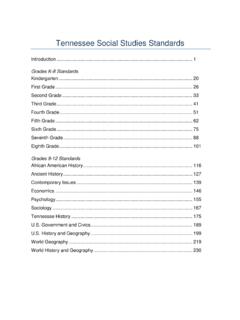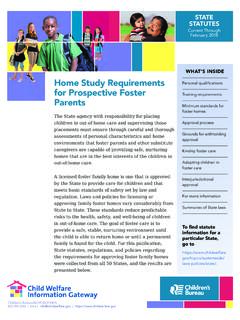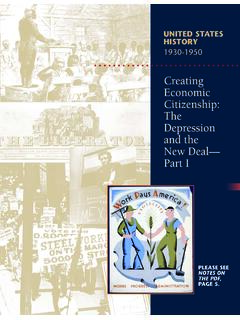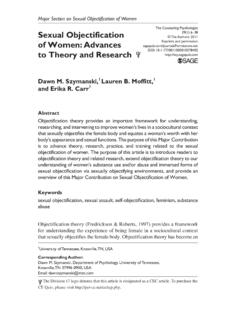Transcription of Cognitive and Constructivist Strategies for Teaching - ed
1 Forum on Public Policy 1 Cognitive and Constructivist Strategies for Teaching about Language and for Providing Reading and Writing Instruction C. Glennon Rowell, Professor in Teacher Education, The University of Tennessee (Knoxville) Barbara C. Palmer, Professor of Reading and Language Arts, The Florida State University Abstract College students learning about language and using this knowledge to learn how to teach reading and writing should participate in Strategies that simulate systems in the language and Strategies that they in turn will use in their own classrooms. Cognitive and Constructivist Strategies are interactive and thus more powerful than the traditional lecture method of Teaching college students, yet too often the traditional method prevails.
2 Four interactive Strategies that we have used successfully are cooperative learning, semantic feature analysis, nonsense story analysis, and fictitious writing systems. Surveys, exams, and informal discussions with students following the use of these Strategies indicate that students found these Strategies to be very effective. Introduction In far too many cases, professors of education indirectly tell their students, even in methodology courses, Teach as I say to teach, not as I teach. Admittedly, lecturing to a class of prospective teachers seems to be the most expedient way to cover the complex content and multiple Strategies that should be taught.
3 It is not unlike the situation that often is cited by teachers in K-12 who state that they are expected to cover all of a prescribed course of study (as usually found in textbooks) by the end of a year or by the time mandatory high-stakes tests are given in their schools. Reading methodology courses exemplify the broad spectrum that encompasses the curriculum in a single disciplinary area. In the past, one three-hour course in reading was often all that was required for elementary education majors (apart from a single course each in language arts and children s literature). However, Teaching the basic components of reading knowledge takes a considerable amount of time.
4 Consider the content and Strategies that most experts agree are the basic essentials to teach in reading: phonemic awareness, phonics, vocabulary development, comprehension, and more recently, fluency (Adler and others1; The National Reading Panel2). In each area, there are numerous facts and Strategies to be taught. For 1 C. R. Adler (Ed.) and others, Put Reading First: The Research Building Blocks for Teaching Children to Read (Jessup, MD: National Institute for Literacy, 2001), iii, 2, 12, 22, 37, 47. 2 National Institute of Child Health and Human Development, Report of the National Reading Panel.
5 Teaching Children to Read An Evidence-Based Assessment of the Scientific Research Literature on Reading and its Implications for Reading Instruction, (Washington, D. C.: Government Printing Office, 2000), 1-3. 3 R. L. Allington, What Really Matters for Struggling Readers: Designing Research-Based Programs, 2nd ed. (Boston: Pearson Allyn and Bacon, 2006), 96-106. 4 D. R. Reutzels and R. B. Cooter, Jr., Teaching Children to Read: Putting the Pieces Together, 4th ed. (Upper Saddle River, NJ: Pearson Merrill Prentice Hall, 2004), 198-199. 5 R. F. Hudson, H. B. Lane, and Pullen, Reading Fluency Assessment and Instruction: What, Why, and How?
6 The Reading Teacher, 58 (8), 702-714. Forum on Public Policy 2 example, to adequately address the best-recognized Strategies for Teaching fluency, identified by Allington as repeated reading, Readers Theater, echo reading, modeling, paired reading, choral reading, and audio-taped reading3, requires a significant amount of time in a three-hour reading methodology course or even two three-hour courses. Then there are other facts/processes that teachers should know about this component of reading, including major skills (automaticity, quality, rate, prosody [pitch and other elements of expression]), benchmark standards, and assessment of fluency (Reutzels, Cooter4; Hudson, Lane, Pullen5).
7 To a lesser extent, the problem of too much content, too little time to teach it occurs in the single secondary reading course that has become a standard requirement for those who wish to become teachers of science, social studies , mathematics, and other subject areas. Recent publishing history backs up our assertion that there is more in reading than can be covered in one or two courses. Furthermore, course expectations are growing rapidly. In the past few years, more books have surfaced in reading instruction with essentials in the title than ever before, suggesting that there has to be a narrowing of what can be included in a basic course or two in reading methodology.
8 In addition, there are more books being published in each of the basic components of reading ( Teaching Comprehension, Vocabulary Development, Phonics, etc.), indicating growth of knowledge about the reading process and Strategies for Teaching it. Going beyond the basic content and Strategies for Teaching each component of reading takes additional time. How to find reading levels, basal readers vs. other kinds of programs (literature-based programs, leveled readers, language experience programs to name a few), integration of reading with writing, primary-reading programs vs. upper-elementary grade reading programs, assessment techniques for reading, and more recently, technology and how to use it in the Teaching of reading extend the knowledge one should know for Teaching reading.
9 In addition, there is the practicum aspect of Teaching reading that includes planning and implementing reading lessons. Concomitantly, both motivation and aliteracy are areas that must be considered, particularly in those courses geared toward instructional design for struggling readers. Added to the fact that professors of reading instruction feel that they must talk through the vast amount of content and Strategies in a limited number of reading courses, there is the continuing, hard-to-break cycle of one Teaching as he/she has been taught. This cycle goes beyond professors of reading to include professors from all fields.
10 The end result is far too often Forum on Public Policy 3 a situation in which there is much less transfer than there should be between what is taught in a college course to the classroom where prospective teachers will be Teaching . Although not as severe as in reading methodology, writing instruction suffers some of the same problems, compounded by the fact that writing is given even less attention because time in the introductory language arts course is usually shared with several other areas such as spelling, handwriting, usage, listening, and speaking. To alleviate this situation, prospective teachers undoubtedly need more than one or two three-hour courses in reading and a single three-hour language arts course where writing instruction is taught.













